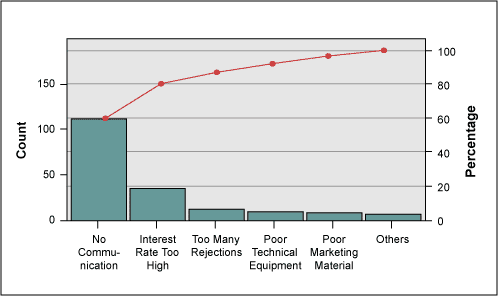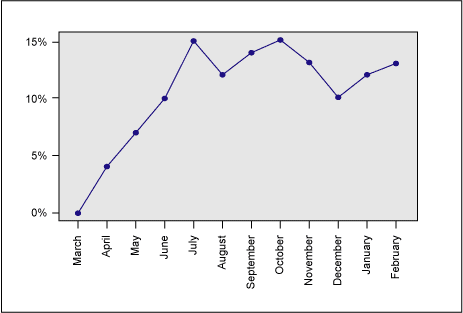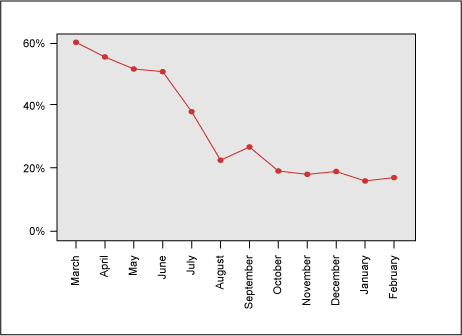
An international bank with 50 branches in Germany and approximately 300 employees decided in 2003 to adopt Six Sigma in all its business units in Europe. It then set out to use Six Sigma to implement one of its priority business strategies – significantly grow its car loan business in the next two years. The bank’s goal was to increase car loans by 100 percent in the first year, and by another 70 percent in the second year.
Pre-analysis Phase
In order to identify appropriate Six Sigma projects, a cross-functional team from sales, marketing and operations was formed to investigate the key drivers of car loan business and market share growth.
The team created a high-level process map and identified of the sub-processes and the relevant influence factors. The indicators were identified through a series of interviews with many process stakeholders. The process stakeholders did not know about process indicators but they were able to explain what kind of “critical numbers” they looked each month. Some of the numbers could easily be translated into indicators; others needed more effort to become obvious (Table 1).
| Table 1: Examples of Process Indicators | ||
| Sub-process | Voice of the Process Owners | Process Indicator |
| Communication with Car Dealers |
“We need frequent contact with our car dealers” | Number of contacts per month |
| “No misunderstanding and communication errors” | Number of complaints from car dealers | |
| “They should generate business” | Car dealer turnover per month | |
| Loan Collection | “Phone handling is important” | Percent abandoned calls; speed of answer in seconds |
A key success factor of this exercise was to have the respective sub-process owners contributing to pinpoint the specific problem areas.
From this pre-analysis, the team identified two Black Belt and two Green Belt projects (Table 2). The distinction between Black Belt and Green Belt was made depending on the urgency of the task. The reasoning was that full-time Black Belts could deal with the problem faster and more effectively than part-time Green Belts.
| Table 2: The Final Six Sigma Projects | |||||
| Process: Car Loan Business Process | |||||
| Find New Car Dealers | Contract with New Dealers | Communication with Car Dealers | Loan Approval | Loan Collection | Customer Service |
| Process Indicators (Indicators in Project Scope in Bold) | |||||
| > Number of New Dealers | > Number of New Dealers Contacted | > Frequency of Communication> Communication Errors
> Car Dealer Activity |
> Approval Cycle Time> Application Errors | > Customer Complaints> Phone Handling
> Payment Issues > Account Reconcillation |
> Inquiries> Customer Complaints
> Phone Handling |
| Black Belt project | Black Belt project | Green Belt project | Green Belt project | ||
Car Loan Project’s Define Phase
The final project definition (Table 3) for one of the Black Belt projects had a narrow scope including only one sub-process – communication with car dealers. After the interviews and after pulling some data from the management information system, at least one reason for starting this project was clear. More than half of the car dealers had not turned over any loans to the bank during the last couple of months. In addition, marketing data told the team that it was much more expensive (about five times more) to acquire new car dealers than to work with existing ones.
| Table 3: The Final Project Definition | |||||
| Process: Car Loan Business Process Sub-process: Communication with Car Dealers |
|||||
| Find New Car Dealers | Contract with New Dealers | Communication with Car Dealers | Loan Approval | Loan Collection | Customer Service |
| Start: Contract with Car Dealer Closed End: Car Dealer Submits Loan Applications |
|||||
| Process Indicator: Car Dealer Activity – Car Dealer Turnover Unit of Measure: Car Dealer Opportunity for Defects: One |
|||||
| Defect Definition: Car Dealer with Turnover Within the Last Three Months (Inactive Rate) | |||||
One of the biggest obstacles at this point was engaging the process owner in the project. The car loan business process owner – the sales director – was one of the few managers who were very skeptical of Six Sigma. Additionally, the team was not used to working as a team: Different office locations for marketing/sales and operations led to a breakdown of communication between these functions. The first team meeting was a very quiet exercise with obvious and hidden finger-pointing.
However, the Black Belt did an excellent job in influencing the process owner, by helping him to understand and see the benefit of Six Sigma.
Lessons Learned:
- Make sure senior management buys in to Six Sigma first.
- Show staff at all levels right from the start that Six Sigma is an imperative that contributes to the strategy of the company.
- Start Six Sigma implementation with needed projects rather than some “learning and training projects.”
Voice of the Customer Is Key
During the interviews performed to identify business indicators and to determine a baseline, the team experienced a common opinion expressed by sales staff: “We could get more ‘turnovers’ if we had better conditions.” This is never a surprise in any business in the world. However, the team decided – as part of the Measure phase – to explore the voice of the customer even more. Supported by an external market research company, the team developed a client satisfaction survey that was conducted by telephone with about 130 car dealers. The results (Figure 1) were a surprise:
- About 60 percent of the dealers mentioned non-existing or poor communication with the bank as the biggest driver for dissatisfaction.
- About 20 percent indicated the interest rate for the car loans seemed too high.

During the Analysis phase, the team focused on those two issues. The team first decided to examine the communication process between the sales team and the clients. Surprisingly, it found that there was no process. The sales representatives complained about the workload they had to do every day. They were kept busy preparing reports, making sales presentations and attending a lot of internal meetings. They did not really focus on talking to their clients. One of the typical comments was: “If I have some time left, I give my clients a call.”
The analysis of the interest rate revealed an additional, even worse issue: Some of the clients did not know the newly reduced interest rate of the bank.
The root cause for this serious fault was that the communication channel between marketing and operations simply did not work well. Immediate action was taken to inform all clients about the better rate.
Lessons Learned:
- Do not assume the company knows what the customers want. Ask them.
- Do not blame people for problems. It is the process which needs to be fixed.
Implementing Solutions and Sustaining the Gain
A couple of days after the market research company talked to the car dealer clients, the contacts produced by the former “sleeping dealers” went up, even though the process had not been touched (Figure 2).

The customer satisfaction survey phone calls had created a positive impact on the car dealers, who perceived that the bank did value them as priority clients. Another reason for business growth was the communication of the new rates, which were more aggressive and competitive.
The Six Sigma team developed solutions for addressing the main problem root causes:
- Development of a communication process between sales representatives and clients.
- Development of a monitoring tool to alarm sales in case of inactivity of clients.
- Refinement of the roles of marketing, sales and operations, resulting in less administrative work for sales personnel in order to give them more time for their first priority – talking to clients.
- Redefinition of internal interfaces to improve communication between departments.
- Production of a marketing handbook to support clients in selling the bank’s services.
Especially during the Improve phase, the presence and support of one of the car dealers was essential. He gave the important input about how often and in what way he would like to be contacted by the sales force.
The solutions required some financial investment. Getting approval was easier than the team had thought it would be. The major factor was the data about the additional business and about the decrease in the rate of inactive car dealers. The team used the data to extrapolate the growth for a one-year period and compared that figure with the estimated cost of the solutions. The sales director supported the solutions 100 percent.
This phase also included:
- Communicating the changes to the whole organization.
- Describing the new process in the operational manual.
- Training all people who were involved in the process.
The Control phase of the project was about putting mechanics in place to make sure the process improvements would last. Part of control was to make the “dealer inactive rate” part of the company’s management information system. The objective was to show the actual inactive rate monthly and to take action if it deviated from the “norm” (Figure 3).

To decide whether a deviation was critical or not, the team implemented a control chart. This was built using the weekly inactive rate after the process had stabilized, a quarter after implementing the changes.
Using a control chart for this purpose seemed to some to be questionable. At the beginning, a lot of education in how to use control charts was needed. It was stressed that the chart was just a measuring device; the importance was in what was done in reaction to movements within or without the control limits.
Lessons Learned:
- Measuring a process tends to change the behavior of people; measuring the right indicators tends to change the behavior in the right direction.
- Involving clients in project work normally builds a long-term relationship, with benefits for both the clients and the business.
- Understanding control charts means knowing they are primarily signals of when changes in the process are significant enough to require action.
Business Improvements: Now and in the Future
After implementing the changes and after the results became obvious, Six Sigma gained momentum within the bank. The start of further Six Sigma projects did not depend on a push from senior management, but became more and more part of normal business. The sales director showed his newly acquired commitment by proposing a Six Sigma team for a reward-and-recognition event at company headquarters.
In addition to the increased profits, the results from this project included:
- The bank gained valuable information about the voice of the clients and their needs, and the impact of internal processes upon that.
- The team experienced the power of teamwork, communication and process analysis, not just the application of complex statistical tools.
- Additional improvement opportunities were identified during the project work, e.g., restructuring the client communication process in other business areas.
Author’s note: Further details of this case study, and Six Sigma in service processes in general, can be found in the book Six Sigma in Transactional and Service Environments by Hasan Akpolat, Gower, September 2004.